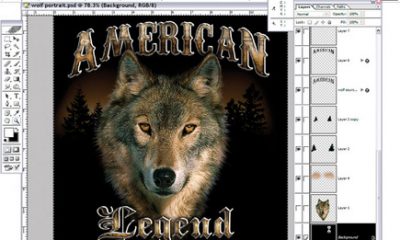Digital Printing
Published
15 years agoon
What’s the next big thing in the wide-format digital-graphics market? The question is so big that I was recently asked to prepare a presentation that would discuss the subject. After thinking about it for just a few minutes I had to ask, “Next big thing for who?”
So much is going on that I think the next big thing will be different for many of the stakeholders in the wide-format market. When I think of a typical wide-format digital printing system, I think of the printer, the RIP, the ink, the media, and usually a finishing system. So let’s look at it from that perspective.
Printers and ink
To me, the next big thing will be to watch the development of durable, water-based, wide-format inkjet printers. This is the segmentation I use to describe HP’s Latex inkjet printer and technology. By now many of the readers know that HP introduced its latex inkjet technology formally at Drupa. The promise of latex is that it will provide the ability to print durable graphics onto uncoated materials, much like in solvent inkjet printing, and support the very high image quality and eco-friendliness of aqueous inkjet printers. Also, while HP certainly headlines the durable, water-based initiative because they are such a big company and garner so much attention, there are at least two other companies, Sepiax and Eastech, that have demonstrated durable, water-based inkjet inks and the same desired properties as HP’s Latex inkjet technology—only these are for use in piezoelectric inkjet printheads.
Just as solvent and UV inkjets have emerged and now represent tens of thousands of printers installed annually, I think we’ll see companies that will integrate piezo printheads and durable, water-based inkjet inks to assemble durable, aqueous imaging solutions that span the market. I’ve written before that I am also very bullish on wide-format, UV-curable inkjet, and that was somewhat more of a sure bet because there were very important market suppliers like Sericol (now Fujifilm Sericol) that have a stake in that segment of the market.
So, why water-based inkjet when there is so much happening in the UV-curable market? Well, I think there is a lot of room for growth in both. There certainly is a tremendous amount of activity in the UV market, and I think it is clear that is where a great deal of the wide-format market is headed. But if the question were about what’ll be the next big thing, I’d suggest that we’re going back to the future with a new version of water-based inkjet that meets today’s requirements for low running costs and higher environmental standards.
Substrates
What I am hearing is that many printing establishments are going back to their tried-and-true brands for wide-format media. It seems that many of the new suppliers and new dealer and private-label brands (frequently called white box brands) have not proven to be reliable or consistent in terms of the quality and performance needed. In North America, that means companies that have been important suppliers to the wide-format-digital market in the past, such as InteliCoat and Neschen, are well positioned.
Also on the print-media front, important vinyl suppliers such as 3M, Avery, Oracal, and others, while having to adjust to a different pricing structure that was forced on them by im-ported vinyl media, have all brought—or will bring—more new products to market that meet the need for low-cost, short-term promotional graphics.
I look for three things in media: more low-priced print media from the market’s most prominent suppliers, media suppliers focusing on options for green media, and more media suppliers providing specific recycling and reclaiming programs for their substrates.
Business building
Some companies have done a good job historically of teaching customers how to get more engaged in specific wide-format-digital applications in order to help them grow their businesses. In my view, this is the kind of marketing assistance that helped make Roland number one in the eco-solvent inkjet-printer segment for the past couple of years.
I’m seeing a lot more of these kinds of market-development activities from manufacturers and distributors in the wide-format-printing market, especially in application training and certification seminars that distributors and vendors are working on together right now around vehicle graphics. I expect we will see a lot more of this kind of activity, because as some segments of the market mature they will look for new applications to help fuel the growth of their businesses.
The other thing that I think might be coming is something I’m calling the end of the line. I’ve heard over and over in recent conversations I’ve had with various vendors that companies in today’s operating environment have to prioritize resources—meaning there’s no bottomless pit of cash they can go to fund ongoing development of products that suit all markets and address everybody’s needs. It simply can’t happen. Parts of the market are too mature and too sophisticated, which makes continued new product development too expensive. Even the biggest companies in the market can’t simultaneously richly fund development for all of their various projects.
So much of the market growth in wide-format imaging is in digital, which leads me to think we’ll see a lot of vendor and product activity over the next few years that indicates the end of development in some areas. In other words, one of the next big things in wide-format digital will be to stop working on the last big thing.
Service
One of the more interesting developments I saw at drupa was a demonstration of a remote monitoring system that was on display at the GBC booth. The system consists of a number of small cameras, a user interface, and some rapid image-compression/decompression technology that made it so the finishing-system operator could look at various parts of the high-speed laminating equipment to monitor the status of the machinery. The user could slow down and zoom in on the images to see where and how problems could arise. The system also was connected so the operator could click and log into customer service to get technical assistance. The customer-service rep could then log in and look at the same images as the user.
This is one of the most advanced technical-support ideas I have ever seen in the printing market, even when I consider some of the other initiatives—like the online technical-support video and technical-service knowledge database that companies like Durst have developed. Durst has won awards for its efforts, and to me it looks like there is a real opportunity for more advanced online and technical support from the vendor side that could improve service and, thereby, reduce the downtime that printers experience with their wide-format printers and finishing equipment.
ICM
People often joke that consultants love acronyms. I don’t love them as much as I love one of the developments that is clearly on the rise in the printing business: the transformation from PSP (print service provider) to MSP (marketing service provider). One of the tools used for this is called Integrated Campaign Management or ICM.
Commercial printers rely on ICM in many cases to ensure the use of the same colors and content on e-mail marketing campaigns, postcards, and Websites, but then ICM ceases at wide-format promotional graphics. Commercial printers could use color-management tools and simple templates to easily extend marketing campaigns to wide-format graphics to develop a one-source, consistent, powerful marketing message.
Standards
I really believe the market is getting close to wide adoption and adherence to the environmental standards in development through the Sustainable Green Printing Partnership (SGP Partnership). SGP is not alone in its efforts to reform wide-format and other printing processes to achieve a greater level of sustainability. I believe that in the next five years we will see a set of standards for sustainability that various printing markets will adopt (commercial printing, packaging, label printing, wide-format, and so on). The standards will become a must-have for printing establishments that want to do business with major corporations, government, and educational institutions.
Thinking about tomorrow
I was at a meeting today with a colleague who said, “Look how fast things are changing. I’d love to be alive in 2050. Can you imagine what the world will be like then?” Nobody has a crystal ball (that would make my job SO much easier!), and I wouldn’t dare suggest that I know for certain what will happen, but the next big things—the major product and market developments that impact the wide-format business in the next three to five years—in my view will be what they’ve been all along: vendor- and distributor-developed technologies, processes, and solutions that solve the problems that print-service providers face every day.
Tim Greene has worked at InfoTrends (formerly known as CAP Ventures) since 1997 and has been the director of InfoTrends' Wide Format Printing Consulting Service since 2001. He is responsible for developing worldwide forecasts of the wide-format-printing market and conducting primary and secondary research. Greene holds a bachelor's degree in management from Northeastern University. He can be reached at tim_greene@infotrends.com.

Subscribe

Magazine
Get the most important news
and business ideas from Screenprinting Magazine.
Most Popular
-

 Art, Ad, or Alchemy1 month ago
Art, Ad, or Alchemy1 month agoF&I Printing Is Everywhere!
-

 Case Studies1 month ago
Case Studies1 month agoHigh-Density Inks Help Specialty Printing Take Center Stage
-

 Andy MacDougall1 month ago
Andy MacDougall1 month agoFunctional and Industrial Printing is EVERYWHERE!
-

 Columns2 weeks ago
Columns2 weeks ago8 Marketing Mistakes Not to Make When Promoting Your Screen Printing Services Online
-

 Editor's Note2 weeks ago
Editor's Note2 weeks agoLivin’ the High Life
-

 Marshall Atkinson2 weeks ago
Marshall Atkinson2 weeks agoHow to Create a Winning Culture in Your Screen-Printing Business
-

 Thomas Trimingham2 months ago
Thomas Trimingham2 months ago“Magic” Marketing for Screen Printing Shops
-

 News & Trends1 month ago
News & Trends1 month agoWhat Are ZALPHAS and How Can You Serve Them in Your Print Business?






